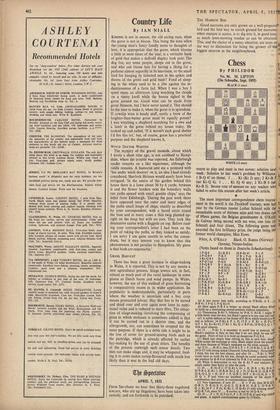Chess
By PHILIDOR No. 96. M. LIPTON (Die Schwalbe, Sept. 1955)
BLACK (3 men)
ti
WHITE (12 men) WHITE to play and mate in two moves: solution next week. Solution to last week's problem by Williams: I B-Q 4! no threat. I . . . Kt (Kt 2) any; 2 Kt-B 5 (set Kt-Q 6). 1 . . . Kt (Q 4) any; 2 Kt-B 6 (set Kt-B 3). Severe vote of censure on any readers who failed to solve this mutate after last week's article.
The most important correspondence chess tourna. ment in the world is the Dyckhoff tourney, won last year by the German master Lothar Schmid with the remarkable score of thirteen wins and two draws out of fifteen games, the Belgian grandmaster A. O'KellY a de Galway being second with ten wins, one loss (to I; Schmid) and four draws. The following game wa! 3 awarded the first brilliancy prize, the judge being the former world champion, Max Euwe. White, A. O'KELLY Black, 0. BARDA (Norway) Opening, Nimzo-Indian.
(Notes based on those in Deutsche Schachzeitung) it (a) A new move: best reply, according to O'KeIly, is 4 . 'I P-B 4!; 5 P-Q 5, P-Q Kt 41
(b) Here again P-B 4 is better: as played Black allows White to build up a dominating central position without opposition.
(c) Threatening B-Kt 5, followed by P-K 5: Kt-K I might b.. a little better than the text, but Black's game is in any case very bad'
(d) A subtle defence to the threat of P-Kt 4, which would now bl met as follows: 14 P-Kt 4, P x P' 15 1' x P, Kt x K PI; Q P x Kt, Kt-Kt 61; 17 Kt x Kt, Q x BP ch; 18 B-Q 2, Q X P with good chances.
(c) 15 . . . P-Kt 3; is necessary to avoid loss of material, IA! Black's position is then so bad that I do not think he can say the game. Point of text is to hold up dangerous I'-Q 13 4. (f) Black had clearly been relying on this to save him: shod' White accept the exchange at once, Black might block the positiO and draw because of White's weakness on the white squares. (g) If 21 R-R 2; then 22 P-B 5, P x P; 23 13-Kt 5, Q-K 131 24 0-01 with strong attack (Deutsche Schachzeltung). Neverther I think this was the best chance, and after 24 .. . P-Kt 3; WO would have to work for his win, though he could probably brisk the position by B-B 6 ch followed by P-R 5 at correct momenM,
(h) White is determined to win the K Kt 1' and maintain lo attack rather than hurry to take the rook.
k
1 P-Q 4 Kt-K B 3 16 P-Kt 41 P x P 2 P-QB4 P-K 3 17 B x P ch K-R I 3 Kt-Q B 3 B-Kt 5 18 P-K B 41 Q-K 2
4 P-B 3 (a) P-Q 4 19 13-Kt 6 R-B 41(f) 5P-QR3 BxKtch 20BxKt1 RXB 6 P x B P-B 3 (b) 21 Kt-Kt 3 R-B 4 (g) 7 P-K 3 P-Q Kt 3 22 P-R 51(h) (h) B-Q 2
8PxP B P x P 23 Q-Q 1 R-Q B 1
9 B-Q 3 0-0 24 B-Q 2 Q R-B 1
10 Kt-K 2 Kt-B 3 25 Q x P Kt-Kt 6 11 P-K 41(c) Kt-K R 4 26 R-Q R 2 B-K 1 (t) 12 P-K 5 P-B 4 27KtxR R x R
13 P-K R 4 Q-B 21 (d) 28 B-K 3 Q-Q B 2 . 14 Q-B 2 Q-B 2 29 R-Kt 11 (J) B x P 15 B-K 3 Kt-R 4 (e) 30 R-R 1 Q-B 2 31 P-B 4l Resigns (k)
a
(I) 26 . R (4)-B 2; 27 Q-Kt 6 Kt x II; 28 R x Kt, B-K 29 P-R 6, K-Kt 1; 30 R-K Kt 2, Q x P; 31 Kt-K 21, Q-R 8 ell! 32 K-Q 2, Q x R; 33 P x P. Q-R 2; 34 P x R=Q ch, K x 001 35 Q x P and wins—an excellent example of the depth
combination that occurs in correspondence chess. /
(J) Very ingenious: if now 29 . . Q x P ch; then 30 13-0,1,.
Q-B 2; 31 R-Q B 21, Q-Q 2; 32. R-B 81, R-B 2; 33 P-R ■ Q x R; 34 P x P ch, K-Kt 1; 35 Q-Kt 61 with winning direst' of Q-R 7 ch, since 35 ... B moves; is met by 36 Q-R 61
(k) 31 ... P x P; 32 P-Q 5LP x P; 33 P-K 61 and wins bishop and game. A superb combinational game by O'Kelly,












































 Previous page
Previous page